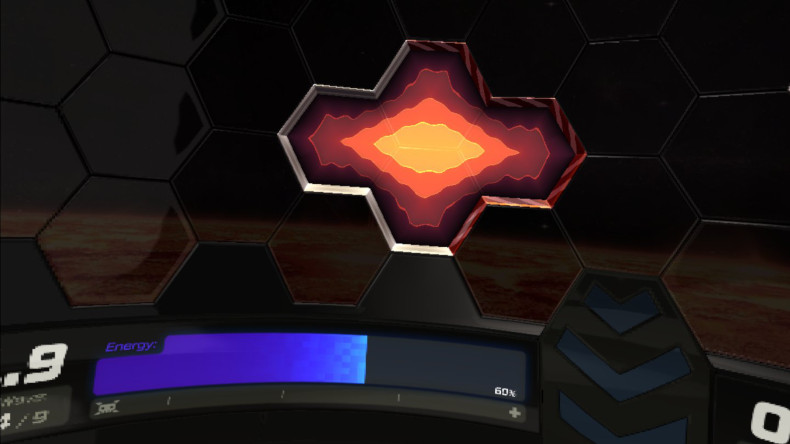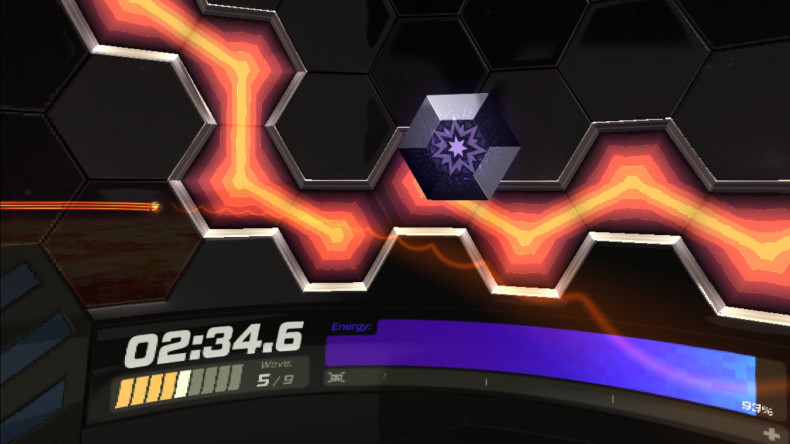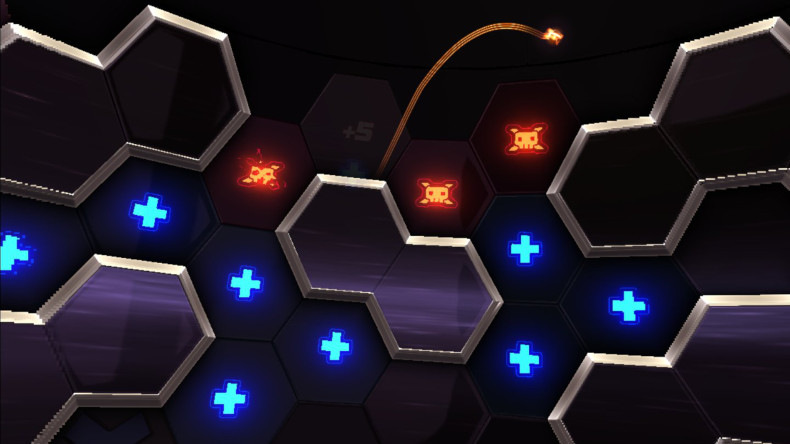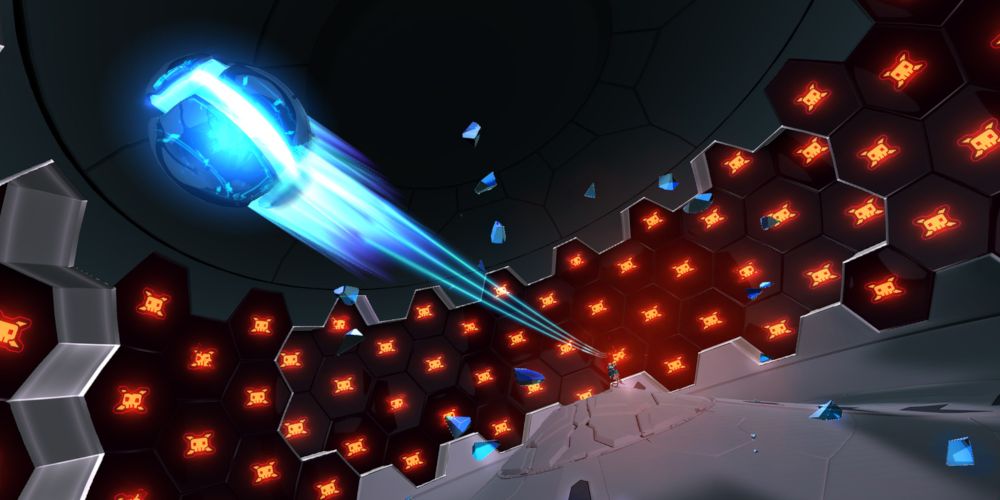"Racquetball meets Breakout in a giant pinball machine!"
This is how the developers of Racket: Nx describe their game, and already it's a mess. Going off of that description alone, what do you envision the gameplay to be like?
Ask ten different people and they'll give you ten different answers, and that's one sign of a poorly conceived game idea.
Don't get me wrong: Racket: Nx is definitely fun—but it's fun despite its mess of gameplay mechanics, rather than because of them. With several hours of experience and a completed solo campaign under my belt, I honestly still don't understand what this game is supposed to be.
The gameplay trailer doesn't clarify much:
Here's how I would describe it: It's like playing whack-a-mole on a 360-degree dome with a tennis racket and ball in zero gravity, with some other stuff like pinball thrown in because why the hell not? And that still doesn't quite convey the game as is.
Disclaimer: My copy of Racket: Nx was provided by One Hamsa. However, my opinions in this review are solely my own and have not been influenced by One Hamsa in any way.
The Good
One Hamsa is pushing hard the idea of Racket: Nx as a futuristic kind of arcade sport, and as soon as you start playing, you really get the sense that this could be a sport played in the future.
The graphics look great, the sound effects are on point, and the immersion factor is off the charts.
Racket: Nx is played within a giant dome of hexagonal cells, where each cell can be one of many types. I don't know what the official names are so I'm making these terms up, but here's the general idea:
- Target cells: You need to hit and kill these.
- Health cells: Replenish your energy when hit.
- Pain cells: Diminish your energy when hit.
- Boost cells: Speed up your ball. More on this later.
- Warp cells: Absorb the ball and spit it out elsewhere.
- And several more, which I won't spoil here.
As you kill target cells, you also build up charge in the lanes. Once the lanes are charged fully, you can hit one of the lanes with the ball, which empowers it to cause a lot more damage on the next strike.
It's a fun mechanic that introduces elements of decision making and risk-versus-reward. ("Is this a good time to use my lanes?")

Racket: Nx has a second kind of decision for you to make: pressing the trigger button magnetically attracts the ball toward your racket. There's no cost or penalty to using this ability, but the pull isn't instantaneous.
You need to think about which way the ball's flying and how fast it's flying before you try pulling it, otherwise it may fly back to you on a weird return path or slow down and take too much time reaching you.
I really like this magnet ability—which sometimes feels like paddle ball when you repeatedly strike and pull the ball—because it gives you more control over the game beyond your racket strikes. There's a skill to using the magnet properly.
The third kind of decision ties into the dexterity aspect of Racket: Nx, which is the ball's spin. Depending on how you hit, the racket actually imparts spin to the ball, causing its path to curve and changes how it interacts with the dome on impact.
I love that you can affect how much the ball spins with your striking technique, and it seems to reflect real-life physics quite well (based on my personal experience with tennis and table tennis, anyway). Slicing the ball, for example, imparts a lot of spin.

There's one more thing I like in Racket: Nx, and it might just be my favorite part of the game: powerups occasionally appear in the form of shields that float around the dome.
They're hard to hit because they move, and you have to hit hard enough to shatter them, but it's so satisfying when you do. It's not the powerup effects that I love, but rather the need for accuracy to break these shields, as they can't be reached by simply rolling the ball along the dome.
Powerups include splash damage, hyperspeed, god mode, and more, which are great for shaking up gameplay.
These are the most fun aspects of Racket: Nx, and I wish these were the only aspects of the game. Unfortunately, there are several more mechanics involved, and this is where the gameplay starts to go downhill.
The Bad
Recall that One Hamsa describes Racket: Nx as a mix of racquetball, Breakout, and pinball. Where are the pinball elements?
Well, here's what happens when the ball hits the dome: if it doesn't have much velocity, it bounces back; but if it does have enough velocity, it rides along the dome until it loses velocity, at which point it returns toward you.
Furthermore, there are actually two depths to the cells on the dome. Some cells are flat against the dome, while others are raised—and these raised cells provide a wall around their perimeter.
If the balls enters the dome on a raised cell and rides over a wall, it can keep going. But if the ball travels along the lower level and hits a raised cell, it bounces off the cell's wall. This often causes a ricochet effect between multiple walls, hence pinball.
I really hate this dome-riding gameplay mechanic. While there are no elements of randomness or luck in Racket: Nx, it sure feels like there are—and that's why this game doesn't really sit well with me, despite my background in competitive gaming.
The pinball elements cover up for a lot of deficiencies in accuracy and precision, closing the gap between skilled and unskilled players. "Lucky hits" exist in all sports, but they are especially prevalent in Racket: Nx.
And is this really a surprise? Pinball is known for this kind of stuff, after all. I personally feel like it's completely unnecessary and the game would be much better without it.

Speaking of unnecessary gameplay mechanics, the decision to have passive energy drain is a huge bummer.
The existence of pain cells already provide a way for the player to lose energy, and the time goals in Solo mode already provide an incentive for the player to perform. There's really no need for energy to drain on its own, and it's frustrating to lose because of it.
Why not shift the cost over to the magnet ability? That way the energy drain is in control of the player and also helps alleviate magnet spam. Win-win.
In the end, Racket: Nx is just too abstract. You can't explain how to play in one sentence, which points to how unnecessarily convoluted the gameplay design is, and most of it stems from the pinball elements. It feels like a mix-match of many separate ideas that are fine on their own but don't mesh well together.
There's no sense of cohesiveness in the game's design decisions, and the result is messy.
The Verdict
In addition to Solo mode (time challenge with fixed target patterns), Racket: Nx also has an Arcade mode (endless survival in both Classic and Zen varieties) and a Multiplayer mode (where you play one-on-one with someone over the internet). At this point, I think Classic Arcade is my favorite mode.
Allow me to repeat: Racket: Nx is a lot of fun. At the end of the day, hitting a ball at targets on a wall is surprisingly engaging, and even though all the other unnecessary stuff gets in the way of that, it's not so bad that you can't overlook it.
If the idea of 360-degree racket-based whack-a-mole sounds appealing at all, you should really consider Racket: Nx. If nothing else, it's a one-of-a-kind experience that everyone should try at least once.
Racket: Nx
Racket: NxThe Good
- Excellent futuristic graphics and immersion
- The individual gameplay mechanics are clever for VR
- Fun to smack the ball around even if you don't know what's going on
- Good value for the price, especially if you're into multiplayer PvP
The Bad
- The whole is less than the sum of the individual gameplay mechanics
- Base gameplay concept is fun, but additional gameplay elements detract from the fun
- Exciting at first but grows increasingly frustrating with more experience
